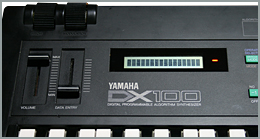How to Play
Many people experience difficulty enunciating words when they first play on the Talkbox. Talkboxes can be played in any language, including Japanese, French, and of course English. You might want to first try practicing the basic vowels in English if you face this problem. Lets try voicing the “A, E, I, O, U,” vowels.
- Pronouncing different vowels at different pitch (e.g. C3= [a] sound as in “wah”, D3= [e] sound as in “way”, E3= [i] sound as in “bee”, F3= [o] sound as in “low”, and G3= [u] sound as in “who”)
- Pronouncing different vowels in same pitch (e.g. C3= [a] sound as in “wah”, C3= [e] sound as in “way”, C3= [i] sound as in “bee”, C3= [o] sound as in “row”, and C3= [u] sound as in “who”)
- Pronouncing different vowels while holding a continuous pitch (e.g. C3= [a] ~ [e] ~ [i] ~ [o] ~ [u])
At first, exaggerate the changes in the shape of your mouth while pronouncing the vowel sounds. Once you feel comfortable doing this, try stretching and shortening the vowels and doing the same one octave higher and lower, and then 2 octaves higher and lower.
After you master the vowels, try words with the “r” sounds that use your tongue for articulation, and adding hard “s” and “th” sounds that needs to be voiced yourself. Even with these practices, you may come across words that will be very difficult to articulate. These could be due to the size of the tube, volume, and/or timbre. Large tubes tend to make articulation difficult, so I recommend trying out tubes smaller than 12mm in diameter. Volume should be adjusted by the power amp to be somewhere close to your natural singing volume. When you are having difficulty with too much low frequencies, the sound is most likely too thick and round; try adjusting the sound or cutting the lows by EQ. When you are having difficulty with high frequencies, the sound is most likely too thin and sharp. Try adjusting the sound and/or cutting the highs by EQ.
Monophonic Mode
Polyphonic means the keyboard can produce more than one sound at once and monophonic means the keyboard can only produce one sound at a time even when multiple keys are pressed on the keyboard. Old synthesizers (like the Minimoog) were monophonic due to technology and cost issues, but with technology improvements, most recent synthesizers are polyphonic with a feature called the “monophonic mode”.
Monophonic mode is added to synthesizers to emulate old synthesizers and woodwind instruments that can only produce one sound at a time. Since the human voice can also produce a note at once, the monophonic mode is necessary when playing the talkbox. Monophonic mode also has a cool feature called either portamento or glide. Portamento/glide is a function to add a smooth transition between two notes. Some products have 2 additional function to the portamento/glide called full-time and fingered. Full-time adds portamento/glide automatically to every note and fingered shifts sounds only when 2 keys are pressed simultaneously. FYI, Minimoog only has the full-time function. Use of these functions allow you to perform with a smooth transition (pitch shifting without attack sound) between 2 pitches. Also, only for these functions are performances emulating artists like Stevie Wonder, who sing with lots of small pitch changes (usually less than a whole step), possible.
- Standard set-up on the DX 100 is “MONO” for POLY/MONO setting and “Fingered Porta” for Portamento MODE. TIME should be set-up to 16.
- Standard set-up on the Minimoog is “ON” for GLIDE, and the “5” for its value.
|
|
Modulation
Another key factor to a performance on the talkbox is the Vibrato, but it is impossible to add a natural vibrato just by controlling your mouth/throat on the talkbox. To do this, talkboxers use the “modulation” function. Synthesizers with keyboards have a modulation controller. The form of the modulation controller may vary, like the wheel on the Minimoog and DX 100 and the joystick on Korg products, but using this will add a vibrato factor to your talkbox performance.

Pitchbend and Modulation Wheel on DX 100
Modulation commonly is a triangle or a square wave LFO (Low Frequency Oscillator) that modulates (vibrates) the sound. Pitch modulation with a triangle wave is a vibrato, volume modulation with a triangle wave is a tremolo, and timbre modulation with a triangle wave is a wah-wah effect. Pitch modulation with a square wave creates a sound like an alternating ambulance siren.
To achieve a natural vibrato, choose the triangle wave and shift the modulation controller gradually forward to widen the modulation.
- Standard set-up on the DX 100 is “triangle” for the WAVE of LFO, SPEED at “31”, DELAY/PMD/AMD all set to “0”, SYNC set to “ON”, and PITCH of MODULATION SENSITIVITY to “6”.
- Standard set-up on the Minimoog is to use Oscillator 3 as LFO; set OSCILLATOR MODULATION to “ON”, RANGE at “LO”, FREQUENCY at “+4” and “triangle” for the WAVEFORM.
Pitchbend
The pitchbend is a controller used to smoothly shift the pitch up and down. This can also be done using the portamento/glide function at monophonic mode, but the second key must be pressed to do this and so the shifting pitch is more obvious than you would like for it to be. With the pitchbend, a more linear movement of the pitch is possible. However, overuse of this function could make your performance sound more like a synth solo rather than a singer singing a song. In order to gain a natural singing sound, you would want to slightly press on the pitchbend (half or below half a step) right when you play the key. By effectively using this function, you can add a slight roll to your performance.
|
|
|
